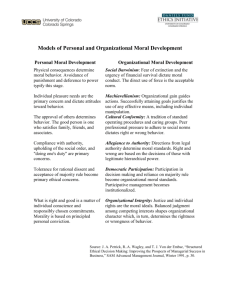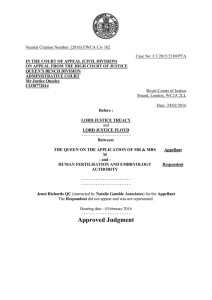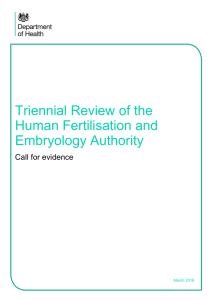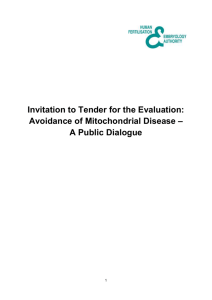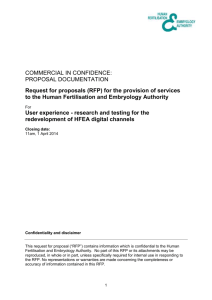HFEAWorkshopABS
advertisement
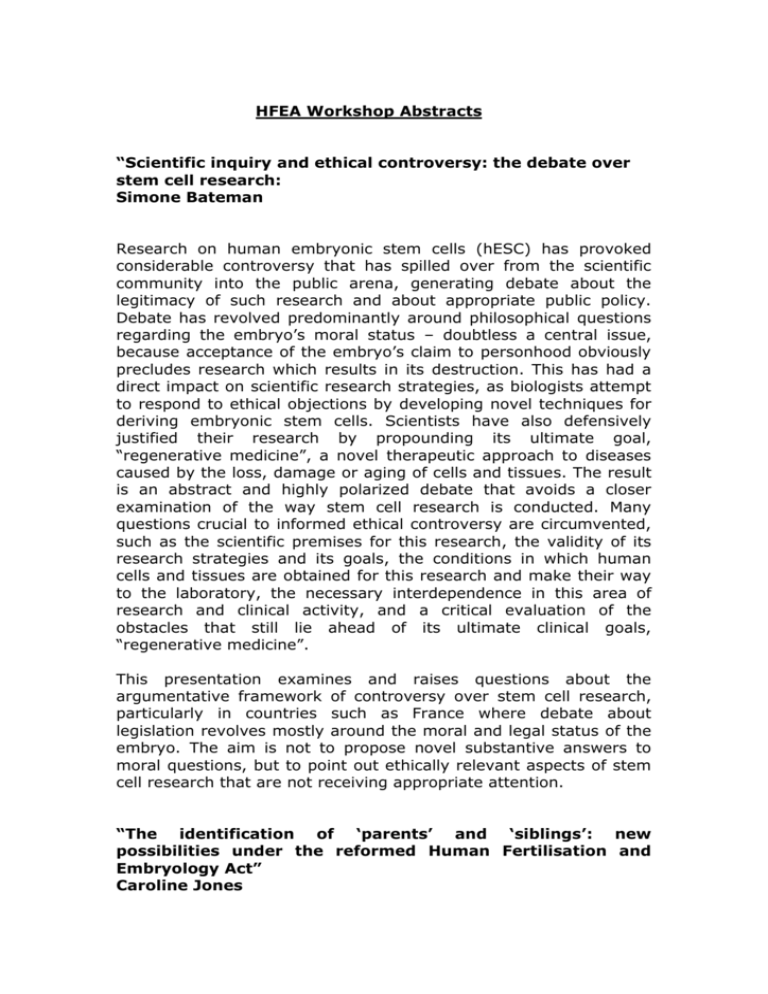
HFEA Workshop Abstracts “Scientific inquiry and ethical controversy: the debate over stem cell research: Simone Bateman Research on human embryonic stem cells (hESC) has provoked considerable controversy that has spilled over from the scientific community into the public arena, generating debate about the legitimacy of such research and about appropriate public policy. Debate has revolved predominantly around philosophical questions regarding the embryo’s moral status – doubtless a central issue, because acceptance of the embryo’s claim to personhood obviously precludes research which results in its destruction. This has had a direct impact on scientific research strategies, as biologists attempt to respond to ethical objections by developing novel techniques for deriving embryonic stem cells. Scientists have also defensively justified their research by propounding its ultimate goal, “regenerative medicine”, a novel therapeutic approach to diseases caused by the loss, damage or aging of cells and tissues. The result is an abstract and highly polarized debate that avoids a closer examination of the way stem cell research is conducted. Many questions crucial to informed ethical controversy are circumvented, such as the scientific premises for this research, the validity of its research strategies and its goals, the conditions in which human cells and tissues are obtained for this research and make their way to the laboratory, the necessary interdependence in this area of research and clinical activity, and a critical evaluation of the obstacles that still lie ahead of its ultimate clinical goals, “regenerative medicine”. This presentation examines and raises questions about the argumentative framework of controversy over stem cell research, particularly in countries such as France where debate about legislation revolves mostly around the moral and legal status of the embryo. The aim is not to propose novel substantive answers to moral questions, but to point out ethically relevant aspects of stem cell research that are not receiving appropriate attention. “The identification of ‘parents’ and ‘siblings’: new possibilities under the reformed Human Fertilisation and Embryology Act” Caroline Jones The reported ‘need’ for, or ‘right’ to information about the ‘truth’ regarding one’s genetic origins has significant purchase in twentyfirst century Anglo-Welsh legal discourse, both within and outside the specific context of donor conception. Genetic links can now usually be proved, although how far, if at all, legal and social relationships can or should be ascribed or denied on the basis of this information is less clear. The focus of this paper is an examination of some issues pertaining to the interests in knowing one’s genetic origins, in the wider sense provided for by the 2008 Act. ‘Interests’ rather than ‘rights’ are highlighted here as the analysis focuses on the types of interests, and crucially, whose are promoted and protected by the legislative provisions. As the paper will show there are mixed messages in the 2008 Act, whereby some genetic ties are promoted in ways that arguably facilitate future information-sharing and possible contact/relationships, whereas others are privileged and protected from potential encroachment by those outside the ‘legal family’ - despite the existence of a shared genetic heritage. “Rewriting Parenthood: Reproductive Technologies and the Sexual Family” Julie McCandless and Sally Sheldon Reproductive technologies have a well rehearsed ability to confuse and disrupt our understandings of parenthood. In this paper, we seek critically to analyse the parenthood provisions of the Human Fertilisation and Embryology Act 2008 Act, assessing both the innovations introduced in that statute and what was retained from the 1990 Act. While the 2008 Act has been attacked as dangerous and radical, as offering a ‘lego-kit model of family life’ and a ‘magical mystery tour’ in how legal fatherhood is determined, we elucidate what the new legislation also owes to deep-rooted, rather traditional assumptions about what a family ‘looks like’. We are particularly interested to track how far law’s adherence to the ‘sexual family’ model can be maintained in a context where this appears to be becoming unmoored from its traditional underpinnings in the heterosexual couple. In this light, we attempt to track some of the tensions created in these legal principles by attempts to stretch this model to accommodate family forms which fall outwith its previous boundaries. Further, we wish also to assess what fell beyond the limits of these discussions, to question what was simply unthinkable to the legislature, what possibilities were undiscussed in this process and why they went undiscussed? The 2008 Act introduces a number of changes relevant to parenthood. Here we consider just two: the removal of the statutory requirement for clinics to consider the ‘need for a father’ when making an assessment of the likely welfare of a child to be born following use of a regulated procedure; and the reworking of the ‘status provisions’ regulating who should be recognised as the legal father of children conceived using technologies regulated by the statute. In seeking to understand the impetus for the 2008 Act, we draw on the extensive documentation produced in the reform process which proceeded it and an ongoing programme of interviews with those who were most closely involved in that process. “Governance regulation?” Derek Morgan in vitro: assisted reproduction after This paper presents, explores and defends a case for disbanding the HFEA. Nice people, sound(ish) ethics, reasonably good job, wrong regulation. Assisted conception is a market activity (Spar, The Baby Business); English law has supinely followed market dictates and the HFEA has been constitutionally obliged to follow. More than that, English law and the HFEA have helped to construct the necessary conditions for a market state (Bobbitt, The Shield of Achilles) rather than a moral state (Weiler, ‘Thou Shalt Not Oppress a Stranger’) in reproductive medicine. It serves, services and supports a moral economy which is bankrupt. The HFEA offers a case study in what Montgomery has called the ‘demoralisation of medicine.’ Substantive moral debate has been excluded from medical practice – including reproductive medicine – by formal rules and administrative regulation, supplemented by an on inherently positivistic jurisprudence. People as patients have been consumed by consumerism and consumer law. Transparent moral governance (governance in vitro) can only be achieved through moral debate and argument –not in the pale shadow reflected on the shores of the HFEA. Contrary to the report of the House of Commons Select Committee on Science & Technology, Reproductive Technologies & the Law, (2003 – 05) (Report HC 7 I and II; HC49), advocating liberalism in reproductive medical law, we need a renewed commitment to Alistair Campbell’s liberation in health, freeing us from the constraints of regulatory repose and moral quietus. The regulatory framework of the HFEA has grown in the face of and partly as a response to a decline in trust a market in health market states producing the economic phenomenon of ‘miswanting’ (Schwartz) arbitrariness rather than consistency medicine as a science and not as an art science as a business (and a corrupt one at that (Campbell)) Taken together, these have delivered us to Huxley’s Brave New World, in which there is no place for ethics, or as would conceive it here, mature ethical debate. In place of this, to relieve the human condition (McKenny), we need to search for a lengthened foresight (Jonas) achieved through a commitment to strong democracy (Barber) in reproductive decision making. “Choosing for/against disability: PGD and the new HFE legislation” Jackie Leach Scully This paper will consider the clause in the Human Fertilisation and Embryology Act 2008 preventing the use of embryos or gametes that carry gene loci associated with a severe disorder or condition, where alternative ‘normal’ embryos or gametes may be used instead. It will look at the initial public response to the draft Bill from members of the community that felt itself most directly affected, the signing Deaf community, and the wider counterresponse. I will argue that both the empirical and the ethical rationales for the inclusion of this puzzling clause are unconvincing. I will also suggest that the response of the Deaf community in these debates was and continues to be misunderstood, in that it has less to do with the practical impact than with the expressive function of the clause; and that this has some general implications for future legislation and policy. “Saviour Siblings: is the HFE Act 2008 too restrictive?” Stephen Wilkinson This paper critically assesses the ethical arguments underpinning two provisions in the HFE Act 2008. The first is that ‘saviour’ selection (selecting an embryo in order to provide, after birth, tissue to treat an existing person with a serious medical condition) is limited to biological siblings (or half-siblings). The second is that ‘saviour sibling’ selection specifically for the purposes of (eventual) whole organ transplantation is prohibited. While it seems likely that neither restriction will have much impact in practice, I argue that the main reasons offered for inserting them are flawed and that, in principle, they should be deleted.





